San Diego Cycads
 Cycads are slow growing plants considered to be living fossils and can grow for several hundreds of years.With unmatched durability in the plant kingdom, these ancient plants are virtually unchanged. They provide us a unique glimpse into the past.
Cycads are slow growing plants considered to be living fossils and can grow for several hundreds of years.With unmatched durability in the plant kingdom, these ancient plants are virtually unchanged. They provide us a unique glimpse into the past.
CHECK THIS OUT..
During the Jurassic period, when dinosaurs roamed the earth, cycads were abundant and varied.
Due to habitat destruction and other contributing factors, many cycads are now endangered and border on extinction.
Who knows, cycads may yet hold some unknown link to our own mortality.
So here at Twin Oaks Ranch, we are working to preserve the incredible legacy of the cycads.
There are some 289 species in 11 genera. Only 8 or 10 species, representing 5 genera, are common in horticulture. Since the 1980's, the popularity of cycads has grown at a remarkable rate.
Below are some of our cycads. Call for current inventory / price.
CYCAS
Cycas Revoluta "Sago"
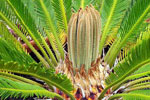 Distribution: The Japanese Islands of Ryukyu
Distribution: The Japanese Islands of Ryukyu
Habitat: Wide-ranging, from temperate to tropical
Description: A low growing Cycad that can reach up to 6’ in height with many decades of growth. Has very dark, glossy green leaves that are stiff and pointed.
Conditions: full sun and well drained soil, frost and drought tolerant
Cycas Thoursaii
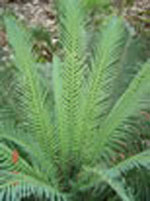 Distribution: Madagascar, the Comores, the Seychelles, and the east coast of Africa
Distribution: Madagascar, the Comores, the Seychelles, and the east coast of Africa
Habitat: Open coastal forest
Description: A large, fast growing Cycad, that can reach up to 30' tall, with attractive, shiny green leaves.
Conditions: partial sun, moist well drained soil
DIOON
Dioon Mejiae
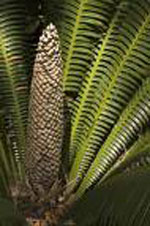 Distribution: Honduras and Nicaragua
Distribution: Honduras and Nicaragua
Habitat: Dry rocky canyons
Description: A small to medium-sized Cycad, with stem that can reach up to 20' in height. The leaves are dark green and flat in profile.
Conditions: mature specimens tolerate full sun, less mature forms require partial shade. Both require well drained soil
Dioon Spinulosum
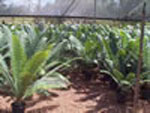 Distribution: Mexico
Distribution: Mexico
Habitat: limestone canyons
Description: The largest of the American cycads, up to 45' in height and 30" in diameter, with stiff leaves and a flat cross-section. The female cone is the largest cone of any gymnosperm, (both living and extinct) and can be up to 40" long and contain 300 seeds.
Conditions: mature specimens tolerate full sun, less mature forms require partial shade. Both require well drained soil
ENCEPHALARTOS
Encephalartos Ferox
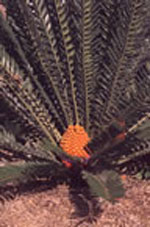 Distribution: southern Mozambique
Distribution: southern Mozambique
Habitat: growing in sand under the evergreen forest or in low undergrowth on sand dunes
Description: holly green leaves are ornamental are up to 6' in length both the male and female cones are red-orange in color.
Conditions: partial shade and well drained soil
Encephalartos Gratus
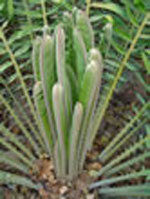 Distribution: southeastern Malawi, northeastern Mozambique
Distribution: southeastern Malawi, northeastern Mozambique
Habitat: deciduous forest, rocky slopes and gorges
Description: medium-sized trunk with leaves up to 6' in length that are dark green and flat.
Conditions: full sun and well drained soil
Encephalartos Horridus
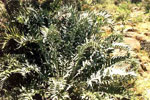 Distribution: Easter Cape Province, South Africa
Distribution: Easter Cape Province, South Africa
Habitat: rocky outcroppings
Description: a small cycad, reaching less than 3' in height with very hard, sharply pointed, blue-grey leaves.
Conditions: full sun and well drained soil
Encephalartos Lehmannii
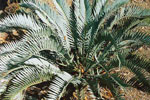 Distribution: Easter Cape Province, South Africa
Distribution: Easter Cape Province, South Africa
Habitat: semi-arid sandstone slopes
Description: a clumping, medium-sized cycad reaching less than 6' in height,with a blue tinge to the leaves.
Conditions: full sun and well drained soil, frost tolerant
Encephalartos Whitelockii
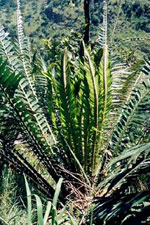 Distribution: western Uganda
Distribution: western Uganda
Habitat: forest along the Mpanga River
Description: large spectacular cycad with trunks up to 15' in height and 3' in diameter, with glossy green leaves.
Conditions: full sun and well drained soil